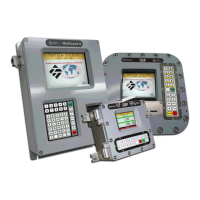Firmware Version 3/4.31.37
7.2 SWING ARM OPERATION
When a swing arm is present and authorized in a bay, that bay's MultiLoad II RCU will show the swing arm as
Idle. Load arms that are in an Idle state are arms that are ready to be used. Viewing the Load Screen of the
other bay's MultiLoad II RCU will show a Swing Arm alarm as the status of the absent swing arm. The swing arm
alarm cannot be cleared and it will not go away until the swing arm is moved back into the bay and its presence is
detected by the MultiLoad II RCU. When a swing arm is absent from a bay, all other load arms in the bay can be
used normally. A swing arm can be returned to a bay without negatively affecting a transaction that is in
progress. For example, a driver may card in to a bay even though a swing arm is being used in the opposite bay.
In addition, loading on other load arms in the bay can commence without the presence of a bay's swing arms.
Any absent swing arms can be brought into the bay at any point during a transaction. When a swing arm is
returned to a bay while a transaction is in progress, the Swing Arm alarm will automatically clear and its status will
change to Idle. As soon as a swing arm's status is Idle, a product can be selected and loading can commence as
with any load arm at the bay. Conversely, a swing arm can be moved out of a bay at any point during a
transaction.
If a swing arm's batch is stopped prior to delivering the preset quantity and the swing arm is moved out of the bay,
the batch on that arm is considered complete. If the arm is returned to the bay while the transaction is still in
progress, there will not be an opportunity to finish the interrupted batch. When the arm returns to the bay, the
status will indicate that the batch is complete. This batch must be cleared by pressing the CLR button before
another batch can be started on the arm. If the transaction is terminated (card out) without returning the arm and
manually clearing the batch, the batch will be archived, along with all other batches that occurred in the bay
during the transaction.
7.3 RELAY AND SWITCH LOGIC
When a swing arm is moved out of a bay, the swing arm's FCM(s) are removed from that bay's MultiLoad II
RCU/FCM communication circuit. Normally, when an FCM fails to communicate with a Remote Control Unit, an
FCM communication failure alarm occurs. But, since the FCM(s) is associated with a swing arm, it is expected
that these FCMs will drop out of the communication circuit from time to time. If a true FCM communication failure
occurs due to open circuits or due to FCM board failure, the failure will be detected by the RCU that has the active
swing arm detector switch. The bay with the active swing arm detector switch is expecting to see all FCMs
associated with the swing arm.
When a swing arm is in a neutral position, both swing arm detector switches will be open and the relay coil will be
de-energized. When the relay coil is de-energized, the normally closed (N.C.) contacts link the swing arm FCMs
to the primary MultiLoad II RCU. Since the swing arm is in the neutral position and no swing arm detector
switches are closed, the primary and secondary MultiLoad II RCUs will show swing arm alarms.
Moving the swing arm into the primary bay closes that bay's swing arm detector switch, indicating to the primary
MultiLoad II RCU that the swing arm is present. The relay coil remains de-energized and the N.C. contacts
continue to link the swing arm FCMs to the primary MultiLoad II RCU. With the closing of the swing arm detector
switch, the swing arm alarm in the primary MultiLoad II RCU clears.
Moving the swing arm into the secondary bay closes the secondary bay's swing arm detector switch. The
secondary MultiLoad II RCU then expects to communicate with the swing arm FCMs. Closing the secondary bay
swing arm detector switch energizes the relay coil. The normally open (NO) relay contacts in the secondary bay
close, connecting the swing arm FCMs to the communication circuit of the secondary MultiLoad II RCU. The NC
contacts of the primary bay are opened as the relay coil is energized, severing the communication link between
the swing arm FCMs and the primary MultiLoad II RCU.

